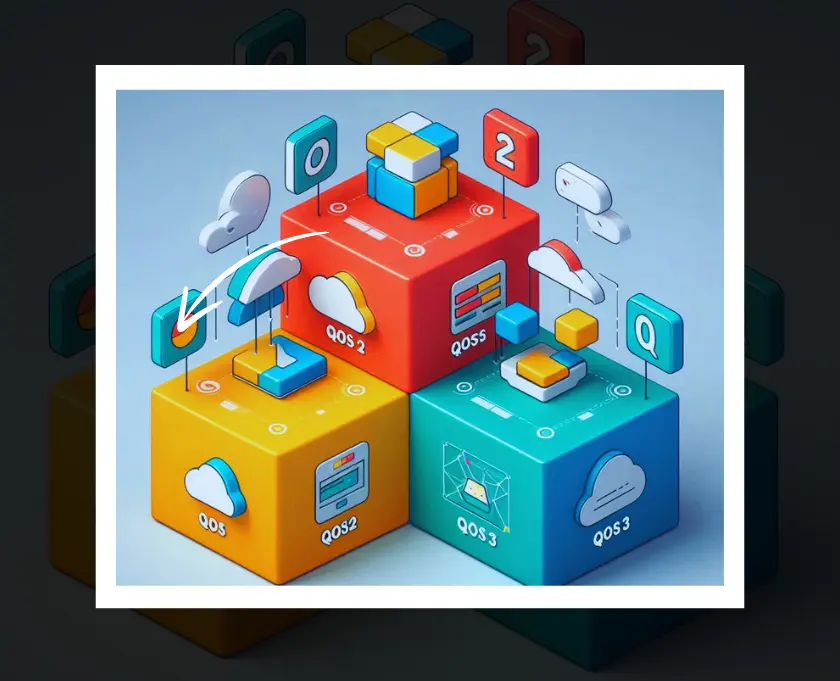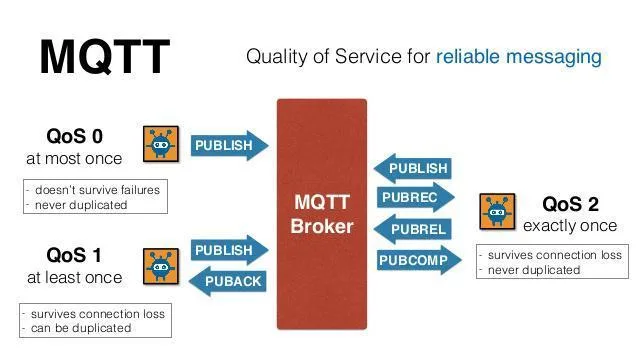![]()
IoT Unlocked: Your Journey to Innovation Starts Now
![]()
IoT Unlocked: Your Journey to Innovation Starts Now

One of the key features of MQTT is its Quality of Service (QoS) levels, which determine how messages are delivered between devices. This article will explore the different MQTT QoS levels, provide real-life examples, and offer guidance on when to use each level.
In the world of the Internet of Things (IoT), efficient and reliable communication between devices is crucial. Message Queuing Telemetry Transport (MQTT) is a lightweight messaging protocol that has become a cornerstone for IoT communications due to its simplicity and effectiveness.
MQTT is a publish/subscribe messaging protocol designed for low-bandwidth, high-latency, or unreliable networks. It operates on top of TCP/IP and is particularly well-suited for IoT applications where devices communicate over wireless networks with constrained resources.
The protocol is lightweight, requiring minimal overhead, which makes it ideal for resource-constrained devices.
Checkout this detailed blog post: How MQTT Works: A Deep Dive into IoT Messaging Protocols
MQTT defines three levels of QoS to ensure that messages are delivered reliably between a client and a broker. These levels are:
Each level provides different guarantees regarding the delivery of messages, and choosing the appropriate level depends on the specific requirements of your application.

MQTT QoS Levels: QoS 0 is the simplest and most basic level of service. With QoS 0, the message is delivered at most once, and no acknowledgment is sent by the receiver. This means that the message is not stored, and if the delivery fails, the message is lost.
Consider a temperature sensor in a greenhouse that sends temperature readings to a central monitoring system every minute. The temperature readings are sent using QoS 0. If a single message is lost, it is not critical since the next reading will be sent in the next minute.
The monitoring system can tolerate occasional losses without significant impact on the overall operation.
MQTT QoS Levels: QoS 1 ensures that the message is delivered at least once to the receiver. The sender stores the message until it receives an acknowledgment from the receiver. If the acknowledgment is not received within a certain time, the message is resent. This level of service guarantees that the message will be delivered, but duplicates may occur.
Imagine a smart irrigation system that uses soil moisture sensors to determine when to water plants. The sensors send moisture data to a central controller using QoS 1. It is important that the controller receives the moisture data to make accurate watering decisions.
Even if a duplicate message is received, the controller can handle it by processing the most recent data.
MQTT QoS Levels: QoS 2 is the highest level of service in MQTT. It ensures that the message is delivered exactly once. This level involves a four-step handshake process between the sender and receiver to guarantee that the message is neither lost nor duplicated. QoS 2 provides the highest reliability but at the cost of increased complexity and overhead.
Consider a financial transaction system where IoT devices are used for point-of-sale (POS) transactions. Each transaction message must be delivered exactly once to prevent any possibility of duplicate charges or lost transactions.
QoS 2 ensures that each transaction is processed only once, providing the necessary reliability for financial operations
Selecting the appropriate QoS level depends on the specific requirements of your application, including factors such as the criticality of the data, network reliability, and the ability to handle duplicate messages. Here are some general guidelines:
MQTT’s QoS levels provide flexibility in managing the trade-off between reliability and performance in IoT communications. By understanding the differences between QoS 0, QoS 1, and QoS 2, and applying the appropriate level to your application, you can ensure efficient and reliable data transmission tailored to your specific needs.
If you found this project helpful or valuable, please consider supporting the creator by buying them a coffee. Your contribution helps in maintaining and improving the project.

MQTT QoS (Quality of Service) levels determine the reliability and guarantee of message delivery in MQTT communication. There are three QoS levels: QoS 0 (At Most Once), QoS 1 (At Least Once), and QoS 2 (Exactly Once), each providing different levels of assurance regarding message delivery.
Use QoS 0 when occasional message loss is acceptable, such as with high-frequency data updates or non-critical information where minimal overhead is preferred.
QoS 2 ensures that each message is delivered exactly once through a four-step handshake process, preventing both message loss and duplication. This makes it the most reliable but also the most complex and resource-intensive QoS level.
Yes, you can mix different QoS levels within a single MQTT application. For example, you might use QoS 0 for non-critical sensor data and QoS 2 for critical control messages.
At QoS 1, the sender stores the message and waits for an acknowledgment from the receiver. If no acknowledgment is received, the sender retransmits the message. This can result in duplicate messages if the acknowledgment is delayed or lost, but the receiver should handle duplicates appropriately.
In less reliable networks, higher QoS levels (QoS 1 or QoS 2) can help ensure message delivery despite potential interruptions. In more stable networks, QoS 0 might be sufficient for non-critical data, as the likelihood of message loss is lower.